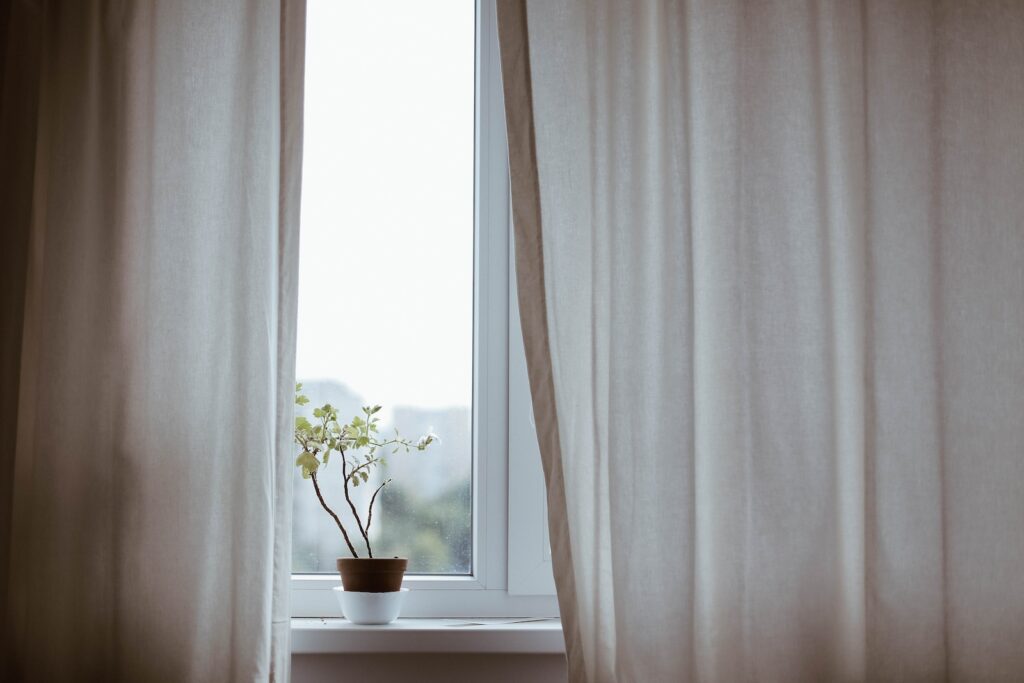Are you tired of feeling a draft every time you walk by an old window in your home? Do you cringe at the thought of your energy bill skyrocketing during the winter months? Well, fear not! There are several ways to make your old windows more energy-efficient, and we’re here to guide you through the process.
By taking a few simple steps, such as installing weatherstripping or adding window film, you can significantly reduce the amount of energy your home loses through its windows. Not only will these steps help save you money on your energy bill, but they’ll also make your home more comfortable year-round. So, let’s dive in and learn how to make your old windows more energy-efficient!

If you live in an older home, you may have noticed that your windows are not as energy efficient as you would like them to be. This can result in high energy bills and a home that is not as comfortable as you would like. Fortunately, there are several things that you can do to make your old windows more energy efficient. In this article, we will discuss some of these methods.
1. Install Weatherstripping
Weatherstripping is one of the most effective ways to make your old windows more energy efficient. This involves adding a strip of material around the edges of your window to seal any gaps or cracks that may be allowing air to escape. There are several different types of weatherstripping available, including foam, vinyl, and metal. Each type has its own advantages and disadvantages, so it is important to choose the one that best suits your needs.
Foam weatherstripping is easy to install and is ideal for small gaps and cracks. Vinyl weatherstripping is more durable and can withstand extreme temperatures, making it a good choice for windows that are exposed to the elements. Metal weatherstripping is the most durable of all and is ideal for high-traffic areas.
2. Add Window Film
Window film is a thin, transparent material that is applied to the surface of your window. It works by reflecting heat back into your home during the winter months and blocking the sun’s rays during the summer months. This can help to regulate the temperature in your home and reduce your energy bills.
There are several different types of window film available, including reflective, low-e, and tinted. Reflective window film is ideal for homes that receive a lot of direct sunlight, as it helps to reflect the heat away from your home. Low-e window film is designed to block out UV rays, which can cause fading and damage to your furniture and flooring. Tinted window film is ideal for homes that require privacy, as it can make it difficult for people to see inside your home.
3. Install Storm Windows
Storm windows are designed to fit over your existing windows and provide an additional layer of insulation. They can help to reduce drafts and prevent heat from escaping through your windows. There are several different types of storm windows available, including interior, exterior, and combination.
Interior storm windows are installed on the inside of your home and are ideal for homes with single-pane windows. Exterior storm windows are installed on the outside of your home and are ideal for homes with double-pane windows. Combination storm windows are designed to be used with both single and double-pane windows.
4. Replace Your Windows
If your windows are very old or damaged, it may be time to replace them. New windows are designed to be more energy efficient than older models, which can help to reduce your energy bills and make your home more comfortable. There are several different types of windows available, including double-hung, casement, and sliding.
Double-hung windows are the most common type of window and are ideal for homes that require ventilation. Casement windows are designed to open outwards and are ideal for homes that require a lot of natural light. Sliding windows are designed to slide horizontally and are ideal for homes that require easy access to the outdoors.
5. Use Window Shades
Window shades are an inexpensive and easy way to make your old windows more energy efficient. They work by blocking out the sun’s rays during the summer months and trapping heat inside your home during the winter months. There are several different types of window shades available, including roller, cellular, and roman.
Roller shades are the most common type of window shade and are ideal for homes that require privacy. Cellular shades are designed to trap air inside their cells, which can help to reduce heat loss and gain. Roman shades are designed to fold up neatly when they are not in use, which can help to reduce clutter in your home.
6. Consider Window Inserts
Window inserts are designed to fit inside your existing windows and provide an additional layer of insulation. They can help to reduce drafts and prevent heat from escaping through your windows. There are several different types of window inserts available, including magnetic, foam, and plastic.
Magnetic window inserts are held in place by magnets and can be easily removed for cleaning. Foam window inserts are made from a lightweight foam material and are ideal for homes that require easy installation. Plastic window inserts are made from a durable plastic material and are ideal for homes that require a long-lasting solution.
7. Add Exterior Shading
Exterior shading is designed to block out the sun’s rays before they reach your windows. This can help to reduce the amount of heat that enters your home and make it more comfortable. There are several different types of exterior shading available, including awnings, shutters, and overhangs.
Awnings are designed to extend from the exterior of your home and provide shade over your windows. They are ideal for homes that require a lot of natural light. Shutters are designed to fit over your windows and can be opened and closed to control the amount of light that enters your home. Overhangs are designed to extend from the roof of your home and provide shade over your windows.
8. Seal Window Frames
Sealing your window frames can help to prevent air from escaping through gaps and cracks. This can help to reduce drafts and make your home more comfortable. There are several different types of sealant available, including caulking, foam, and weatherstripping.
Caulking is a type of sealant that is applied to gaps and cracks around your window frames. It is ideal for small gaps and cracks. Foam sealant is a type of spray foam that is applied to larger gaps and cracks. It is ideal for homes that require easy installation. Weatherstripping is a type of material that is applied around the edges of your window frames to seal any gaps or cracks.
9. Install Window Treatments
Window treatments are an easy and inexpensive way to make your old windows more energy efficient. They work by blocking out the sun’s rays during the summer months and trapping heat inside your home during the winter months. There are several different types of window treatments available, including curtains, blinds, and shades.
Curtains are made from a variety of materials and can be easily removed for cleaning. They are ideal for homes that require privacy. Blinds are made from a variety of materials and can be easily adjusted to control the amount of light that enters your home. Shades are made from a variety of materials and can be easily raised and lowered to control the amount of light that enters your home.
10. Use Window Insulation Film
Window insulation film is a type of plastic film that is applied to the surface of your window. It works by creating an additional layer of insulation that can help to reduce drafts and prevent heat from escaping through your windows. There are several different types of window insulation film available, including heat shrink, static cling, and adhesive.
Heat shrink window insulation film is applied to your window using a hair dryer. It is ideal for homes that require a long-lasting solution. Static cling window insulation film is applied to your window using static electricity. It is ideal for homes that require easy installation. Adhesive window insulation film is applied to your window using an adhesive backing. It is ideal for homes that require a strong and durable solution.
In conclusion, there are many ways to make your old windows more energy efficient. By following these tips, you can reduce your energy bills and make your home more comfortable. Whether you choose to install weatherstripping, window film, or storm windows, there is a solution that will work for you.
Frequently Asked Questions
Here are some common questions and answers about making old windows more energy-efficient.
1. Why should I make my old windows more energy-efficient?
Old windows can be a major source of energy loss in your home. They can let in drafts and allow heat to escape, which can lead to higher energy bills. By making your old windows more energy-efficient, you can save money on your energy bills and make your home more comfortable.
There are several ways to make your old windows more energy-efficient, such as adding weatherstripping, caulking, and applying window film. These methods can help to reduce drafts and improve the insulation of your windows.
2. What is weatherstripping?
Weatherstripping is a material that is used to seal gaps around windows and doors. It can be made from a variety of materials, such as foam, felt, or rubber. Weatherstripping is an effective way to reduce drafts and improve the energy efficiency of your windows.
To apply weatherstripping to your windows, you will need to clean the surfaces where the weatherstripping will be applied and measure the length of the gap. Then, cut the weatherstripping to the correct length and press it into place. You may need to use adhesive to keep the weatherstripping in place.
3. What is caulking?
Caulking is a material that is used to seal gaps around windows and doors. It is typically made from a flexible material, such as silicone or latex. Caulking is an effective way to reduce drafts and improve the energy efficiency of your windows.
To apply caulking to your windows, you will need to clean the surfaces where the caulking will be applied and apply the caulking in a continuous bead. Then, use a caulking tool or your finger to smooth the caulking into place. Be sure to allow the caulking to dry completely before painting or exposing it to water.
4. What is window film?
Window film is a thin, transparent film that is applied to the surface of a window. It can help to reduce heat loss in the winter and heat gain in the summer, making your home more energy-efficient. Window film can also block UV rays, which can help to protect your furniture and flooring from fading.
To apply window film to your windows, you will need to clean the surface of the window and cut the film to the correct size. Then, spray the window with water and apply the film, smoothing out any bubbles or wrinkles. Finally, use a razor blade to trim the excess film from the edges of the window.
5. Can I make my old windows more energy-efficient without replacing them?
Yes, there are several ways to make your old windows more energy-efficient without replacing them. Adding weatherstripping, caulking, and applying window film are all effective ways to improve the insulation of your windows. You can also consider adding storm windows or window inserts to further improve the energy efficiency of your windows.
If you are considering replacing your windows, be sure to choose energy-efficient windows that are ENERGY STAR certified. These windows are designed to meet strict energy efficiency standards and can help to save you money on your energy bills.
Making Old Windows More Efficient
In conclusion, making old windows more energy efficient is an essential step in reducing energy consumption and costs. By following the simple steps outlined in this guide, you can achieve significant energy savings without having to replace your old windows.
Firstly, applying weatherstripping and caulking to seal any leaks and gaps can help prevent air infiltration and improve insulation. Secondly, using window film or adding storm windows can help reduce heat loss and gain, improving the overall energy efficiency of your home. Lastly, investing in energy-efficient window treatments such as blinds or curtains can further reduce heat transfer and add an aesthetic touch to your home.
In summary, improving the energy efficiency of your old windows does not have to be a daunting task. By taking simple steps such as sealing gaps, adding storm windows, and using energy-efficient window treatments, you can enjoy a more comfortable home while reducing your energy bills. Start making your old windows more energy efficient today and reap the benefits for years to come.


